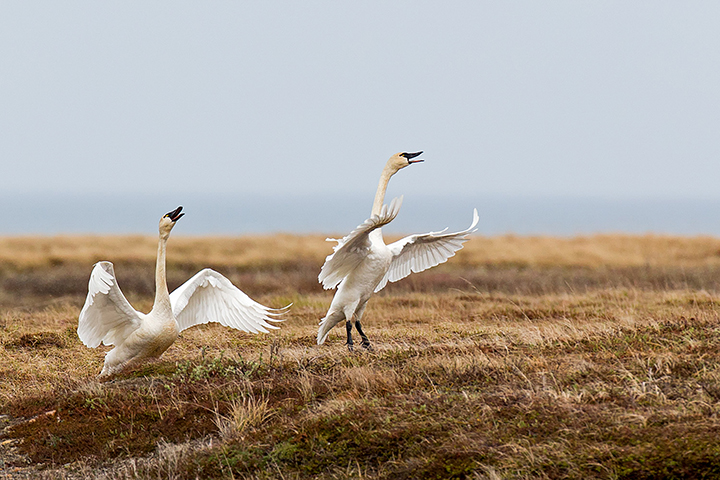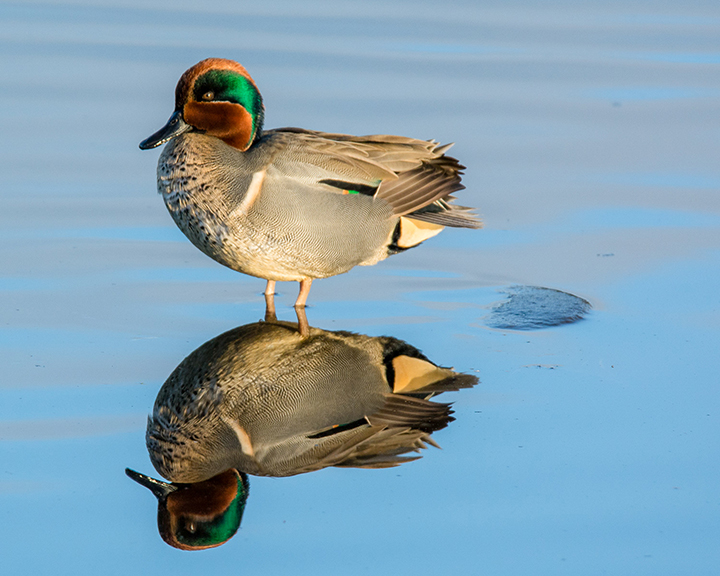
A gentle breeze drifts in from the Atlantic, passing over the rolling waves where children pause in their play looking to the sky, thrilled to watch as an osprey hovers, whistles and plunge-dives for its prey. The breeze carries on, lifting the smell of Coppertone up the dunes to the nostrils of beachgoers, who stop to admire the grace of a dozen brown pelicans soaring overhead.
In a brief moment, the breeze has crossed this narrow stretch of sand to rustle the feathers of herons and egrets along the marsh shore; coastal kayakers delight in their long-legged, long-necked antics. This single breeze envelopes one fragment of time capturing iconic moments and memories that are quintessential to the Outer Banks experience.
Supporter Spotlight
As director of Audubon’s Donal C. O’Brien, Jr. Sanctuary in Corolla, these scenes serve as my daily reminder of what makes this isolated strip of beach and marsh so special—it’s a place where birds and nature still thrive alongside humans. But it was not always so.

In the early 1980s when I first came to the Outer Banks, pelicans were a rare sighting and osprey were not to be seen at all. Human activities, primarily the unregulated use of pesticides and herbicides like DDT, had drastically reduced the numbers of these birds.
Likewise, 80 years earlier, market hunting and the fashion trade—which supplied feathers for women’s hats—had nearly eradicated egrets and herons. It was in those years, at the turn of the last century, when the first bird advocates organized to curtail the plumage trade, to save these species and their vital role in the ecology of the coast. In that time, organizations such as Audubon North Carolina were born. It would take years for new laws advanced by Audubon to pass in the state legislature and Congress, and even more time for birds to rebound, but rebound they would.
So, too, in the 1960s and early 1970s, people of all political stripes banded together to reduce the use of uncontrolled pesticides and herbicides and their impact on our ecosystems. The Clean Air Act, the Clean Water Act, and many others came about in a strongly bipartisan manner during this time.
It took a long time for the toxins to filter out of our environment, for populations to recover for birds such as osprey, whose shells had been so weakened by the chemicals that parents would crush their eggs under their own weight. But as the toxins cleared, birds were more successful at raising chicks, and their populations rebounded.
Supporter Spotlight
My first osprey nest sighting on the Outer Banks occurred in 1991, a decade after I arrived here. Serving as a kayak tour guide, I led tourists past the channel marker into Manteo’s Shallowbag Bay and was startled by the construction of sticks, grass and vines tucked between the triangular markers. Peeking out above this congregation, I saw a small white head with a sharp hooked beak. Soon the mate soared in with a fish securely fixed within its talons. We were beyond ecstatic.
Coastal birds such as pelicans, osprey, egrets and herons not only enrich our lives but also serve as harbingers and heralds of coming change. Whether it be observing their feeding and nesting before a storm, their migrations at the turn of the season, or the literal “canary in a coalmine” warning us of dangerous conditions, birds have a lot to tell us.
Now birds are telling us that changes to our climate are fraying the web of life that binds us all together. Audubon’s latest climate science tells us that two-thirds of North America’s bird species are threatened by rising temperatures and more extreme weather. Nearly half of the 200 species that depend on Audubon’s Pine Island sanctuary will see their ranges dwindle substantially, making them vulnerable to extinction. Sea level rise adds to this vulnerability, threatening to destroy critical habitat along the coast—places where birds feed, mate, and raise their young. Species at risk include beloved birds like the tundra swan, American oystercatcher, and green-winged teal.

As climate changes, birds, who have specific habitat and climate preferences, must change too. They must move. But does the new location have both the climate and habitat they need? How will competition with other species living there affect them? More American white pelicans are now showing up on the Outer Banks. What will the presence of these larger birds mean for the smaller local brown pelicans? These are difficult questions to answer, but it is clear that change is upon us.
There is still hope. We know this because we’ve been here before. As in times past, good-hearted individuals can band together, taking actions such as planting native plants, restoring habitat and turning lights out when buildings aren’t in use to save energy and reduce bird collisions with windows. These individual actions are critical, but so is broader collective action.
Audubon’s climate science tells us that if we limit future temperature increases, the odds of survival improve for the vast majority of birds at risk. In North Carolina, that means transitioning to cleaner, more renewable energy sources. And we need to make this transition quickly, through ambitious, bipartisan policy.
We have faced similar challenges before and we can do it again. It will take decades for the birds to rebound, but—if we take action now and give them half a chance—rebound they will. Resiliency is the nature of nature.
On a tiny fragment of our coast, on a narrow stretch of sand surrounded by water, pounded by storms, together we can ensure a future where children and birds alike play in the waves.
To stimulate discussion and debate, Coastal Review Online welcomes differing viewpoints on topical coastal issues. See our guidelines for submitting guest columns. The opinions expressed by the authors are not necessarily those of Coastal Review Online or its publisher, the North Carolina Coastal Federation.







